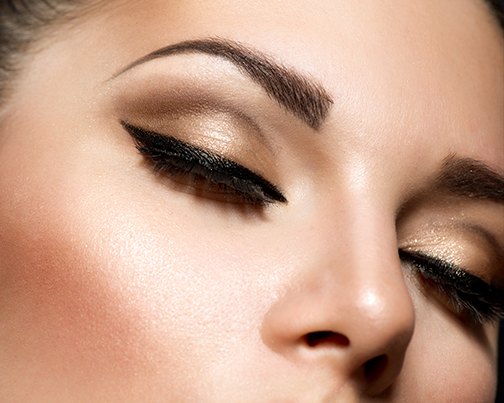New Jersey Plastic Surgeon
POSTED ON THURSDAY, SEPTEMBER 18, 2014 AT 1:12 PM by Dr. Mokhtar Asaadi
 Your brows express a variety of emotions, including anger, depression, surprise, and tiredness. If these expression lines have become a permanent fixture on your face, you may be experiencing premature signs of aging caused by eyebrow descent. These lines may appear between the eyebrows, horizontally on the forehead, or at the bridge of the nose. Oftentimes, these lines are mistaken for excess skin. To treat plunging eyebrows, our plastic surgeon recommends a foreheadplasty.
Your brows express a variety of emotions, including anger, depression, surprise, and tiredness. If these expression lines have become a permanent fixture on your face, you may be experiencing premature signs of aging caused by eyebrow descent. These lines may appear between the eyebrows, horizontally on the forehead, or at the bridge of the nose. Oftentimes, these lines are mistaken for excess skin. To treat plunging eyebrows, our plastic surgeon recommends a foreheadplasty.
A foreheadplasty, commonly referred to as a brow lift, elevates sagging brows into an ideal position, regaining your youthful appearance and removing predated expressions. Advances in the medical field have allowed plastic surgeons to perform this procedure endoscopically.
This technique, also known as a short-scar foreheadplasty, allows for an invisible scar recovery. The procedure uses small incisions within the hair to reposition the brow. The new positioning is held in place with stitches, and after a few weeks the skin will naturally reattach itself to a lifted position. When Dr. Asaadi performs the procedure, he often cuts the corrugator muscle (located at the medial end of the eyebrow) to relax the apperance of frowning. An endoscopic procedure is ideal for correcting a very low brow and can also improve deep lines between the eyebrows and above the nose.
The differences between bicoronal (traditional) foreheadplasty and an endoscopic (short-scar) foreheadplasty:
|
|
Bicoronal |
Endoscopic |
|
Scar |
A long scar that may stretch will be visible post-surgery. |
Scarring is small, hidden by hairline, nearly invisible. |
|
Changes to Hairline |
Your hairline may appear elevated, hair loss is unlikely. |
It is uncommon to experience an elevation in your hairline, and hair loss is unlikely. |
|
Numbing in the Scalp |
Likely to occur. |
Not likely to occur. |
|
Recovery |
Post-op, there may be some bruising. Directly following surgery, you may have a surprised appearance. It may take 1-2 weeks to recovery although itching in the scalp many last for months. |
Bruising post-op is unlikely, and your results will look natural. |
|
Results |
Long-lasting. |
Long-lasting. |
Dr. Asaadi and our staff welcome any questions you may have about brow lift in NJ. Contact our NJ office at 973.731.7000 or request your appointment online today.
Additional Links:
Brow Lift NJ
Neck Lift New Jersey
BOTOX NJ
POSTED ON WEDNESDAY, SEPTEMBER 03, 2014 AT 10:01 AM by Dr. Mokhtar Asaadi
 Migraines can take control of your life. Those who suffer from migraines report being curled in bed, unable to open their eyes, experiencing light and sound sensitivity, and these symptoms last up to twelve hours at a time. These symptoms are long-lasting, and those diagnosed with migraines are 40% more likely to develop depression.
Migraines can take control of your life. Those who suffer from migraines report being curled in bed, unable to open their eyes, experiencing light and sound sensitivity, and these symptoms last up to twelve hours at a time. These symptoms are long-lasting, and those diagnosed with migraines are 40% more likely to develop depression.
The cause of migraines has been linked to blood vessel enlargement that releases chemicals to nerves. The chemical compression on the nerves causes chronic pain and inflammation. Recently, plastic surgeons have discovered a surgical treatment for migraines that will also help you look younger while feeling migraine relief.
Formally just a cosmetic procedure to lift eyebrows and smooth lines in your forehead, the forehead lift provides nerve decompression for your peripheral sensory nerves. With a few minor incisions, your plastic surgeon is able to eliminate trigger sites for your migraines by clipping nerves and removing muscles. The length of this outpatient procedure varies on the amount of trigger points that are treated.
The surgery has a 70% success rate, and patients report immediate results. After surgery, patients will also experience a younger, more rejuvenated look. The long term effects of this procedure are still being studied, and plastic surgeons are just beginning to understand the benefits of a forehead lift.
Surgical intervention for migraine treatments should be a last resort. Before deciding on a forehead lift for migraine treatment, you should speak with your doctor to ensure you’ve tried every other treatment option available. In certain cases, your surgical treatment for migraines may be approved by medical insurance.
Dr. Asaadi and our staff welcome any questions you may have about surgical treatments for migraines. Contact our NJ office at 973.731.7000 or request your appointment online today.
Additional Links:
Botox NJ
Facelift New Jersey
Forehead Lift NJ
POSTED ON MONDAY, AUGUST 25, 2014 AT 5:07 PM by Dr. Mokhtar Asaadi
 Do you struggle to find a bikini that fits your body? Unfortunately, bikinis are not one size fits all, and often, women may struggle with an unflattering appearance due to an ill-fitting bikini. Thankfully, fat grafting offers a natural boost for your bikini, will add volume, shape, and contours to both your breasts and buttocks. This will be the last summer you regret your bikini purchase after scheduling your breast or buttocks augmentation using fat grafting at Mokthar Asaadi M.D. F.A.C.S!
Do you struggle to find a bikini that fits your body? Unfortunately, bikinis are not one size fits all, and often, women may struggle with an unflattering appearance due to an ill-fitting bikini. Thankfully, fat grafting offers a natural boost for your bikini, will add volume, shape, and contours to both your breasts and buttocks. This will be the last summer you regret your bikini purchase after scheduling your breast or buttocks augmentation using fat grafting at Mokthar Asaadi M.D. F.A.C.S!
Fat grafting has a unique benefit over other methods of augmentation; it uses your own, natural fat. During a prior liposuction procedure, fat is extracted from other areas, such as the flanks or love handles. This not only helps sculpt and tone other troublesome areas of fat, but also supplies donor fat to use for augmentation. This fat, whether applied to the buttocks or breasts, feels more natural than implants.
Additionally, fat grafting can be customized to address the concerns of each patient. By transferring your own natural fat, you’re able to correct asymmetry, add additional contouring, and also increase size, if needed. Fat transfer also involves less risk than buttocks or breast implants, reducing the chance of an allergic reaction to a foreign material. It also eliminates the risk of an implant rupture or capsular contracture. The results after fat transfer to your buttocks or breasts is also permanent, unlike implants which usually require replacement after 10 years.
Fat grafting provides patients a safer, more natural choice for breast and buttock augmentation, allowing you to look great and feel confident in your bikini! Dr. Asaadi and our staff welcome any questions you may have about fat transfer in New Jersey. Contact our NJ office at 973.731.7000 or request your appointment online today.
Additional Links:
Fat Transfer NJ
Breast Enlargement New Jersey
Breast Implants NJ
Butt Augmentation New Jersey
POSTED ON WEDNESDAY, JUNE 11, 2014 AT 9:45 AM by Dr. Mokhtar Asaadi
 Your nose is a prominent feature, and thanks to its front and center placement on your face, it effects the balance and symmetry for the rest of your facial features. Men are expected to have wider noses with a strong, straight bridge, whereas women’s noses are expected to have a softer, more slender appearance.
Your nose is a prominent feature, and thanks to its front and center placement on your face, it effects the balance and symmetry for the rest of your facial features. Men are expected to have wider noses with a strong, straight bridge, whereas women’s noses are expected to have a softer, more slender appearance.
Overall, a nose should have complimenting lines and contours that blend with the entire face. If the nose is lacking in balance and proportion with the rest of the face, rhinoplasty, a surgery providing both cosmetic and functional corrections, may be a great cosmetic option to address this concern.
Rhinoplasty is often suggested as a cosmetic procedure for a non-symmetrical, disproportionate nose. It has the ability to straighten your nose, remove visible humps on its bridge, create proportion and symmetry, and correct visible past injuries. Besides the ability to balance your face for a more aesthetically pleasing appearance, rhinoplasty can also improve structural issues impeding your breathing.
Although the goal of open rhinoplasty is to aesthetically improve the appearance of your nose, endonasal rhinoplasty is known to also correct structural issues causing breathing problems by rebuilding the air chambers within the facial skeleton. By having a limited airway, you’re at a higher risk for sleep apnea, sinus infections, and nose bleeds. Sinus infections can become a major hindrance on your life; limiting your ability to breathe and cause head congestion leading to sinus pressure headaches and nose bleeds. Illness such as sleep apnea puts you at a higher risk for heart disease, resulting in heart attacks and even heart failure! Rhinoplasty can help you to breathe better, allowing you to sleep and look better too!
Dr. Asaadi and our staff welcome any questions you may have about rhinoplasty in New Jersey. Contact our NJ office at 973.731.7000 or request your appointment online today.
Additional Links:
Rhinoplasty NJ
Ultherapy New Jersey
Laser Skin Resurfacing NJ
POSTED ON WEDNESDAY, JUNE 04, 2014 AT 4:42 PM by Dr. Mokhtar Asaadi
Dr. Asaadi received another wonderful review from a satisfied patient! She proclaims her treatment gave her “undeniable confidence,” helping her succeed in a local physique competition. This overjoyed patient believes she made the best choice by choosing NJ plastic surgeon, Dr. Asaadi, for her procedures, leading to a “flawless” and “more beautiful” body. Read more of her review below:
 Dear Dr. Asaadi,
Dear Dr. Asaadi,
I wanted to send a progress photo (7 months post-surgery) taken at a local physique competition.
I attribute my success not only to my new body, but the undeniable confidence I exude off and on the stage. Being truly happy with what I see in the mirror has brought forth a world of positives.
For at least 5 years I had thought about making a change. Prior to surgery, my nerves were terrible – after all, the body I've been used to for 30 years was about to change forever! I knew I was in great hands going in, which did ease my anxiety. The minute I became conscious of the results, it became clear I made the best choice. What impressed me the most was my body looked flawless…not one bruise existed. I looked like a more beautiful, natural, and curvaceous version of myself.
I could not be more thrilled with the amazing results of Dr. Asaadi's artistry! With every complement I receive, I recommend your practice for its world-class expertise, professionalism and warmth.
A million times, thank you!!!
Sincerely,
A.G.
Click here to read more reviews about Dr. Asaadi!
Dr. Asaadi and our staff welcome any questions you may have about plastic surgery in New Jersey. Contact our NJ office at 973.731.7000 or request your appointment online today.
Additional Links:
Tummy Tuck NJ
Thigh Lift New Jersey
Arm Lift NJ